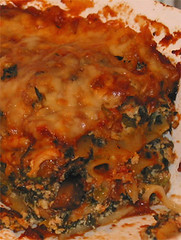Monday 26 February 2007
What's So Awful About Offal?
When I say the word “offal” to you, what comes to your mind? For those of you familiar with the term, “innards” is likely what you’d throw back at me.
What if I asked you if you’d eat offal?
Some of you are probably having a mental gag reflex right now, huh?
Offal seems to get a bad rap from the mainstream North American society, but offal as food doesn’t seem as alien or “gross” (if I may put it that way for some of you) to many peoples around the world. So why is it seen with disdain by many North Americans? I’m siding with the school of thought that believes when European settlers first came to North America they saw it as “land of the plenty” and therefore over time only went for the choicest parts of animals. In much of the Old World, resources have been more limited and therefore as much of the animals have been used as possible. Over time some of the innards have become synonymous with certain cultures (e.g. Scotland’s haggis), while some also have become prized delicacies (e.g. sweetbreads, foie gras). Yet some have even been reputed to hold medicinal qualities (e.g. bear gall bladders).
If you feel so repulsed from eating any offal at all (vegetarians aside), chances are you may have eaten some during your lifetime… you know how many types of sausages are held together? That outer “skin” is often intestinal linings.
“Offal’s so… dirty”
That’s the most common misperception I encounter from people who shun offal. Perhaps the main reason people have this psychological barrier is that some of the organs exist as filters for the animal body (e.g. livers, kidneys). In reality the innards themselves are fine, and strict health standards in North America and Europe help ensure that they are well cleaned before they are sold and served. The biggest concern nowadays is cross-contamination, and this can happen anywhere with any cuts of meat from the slaughterhouse to the kitchen.
“It looks and tastes weird”
Yes, most forms of offal may not look too appetizing in raw form, but then again, many forms of meat don’t look too edible when raw in any case. It may be difficult for some people to open their minds to try some, but this, like the thought of “dirty” offal, is mostly psychological. It can be a tough barrier to break, but once you do so you can perhaps better appreciate these less common cuts of meats, or at least the effort put in by chefs to make them as agreeably edible as possible.
As for taste and texture, there is no denying that offal is different from your typical cuts of meat. All your steaks, chops, tenderloins and what not are essentially muscles and so have that similar structural texture to varying degrees; the fact that they’re all muscles is also why the different cuts from the same type of animal seem to have very similar flavours. Most forms of offal however are not muscles for physical exertion and/or maintenance of body structure and therefore lack that texture. Different innards have different roles in an animal’s body, and that can also affect flavour and texture. Even similar innards can taste different from animal to animal. For example, pork liver tends to have a rougher texture (especially if overcooked), duck liver (AKA foie gras) is smoother, and veal liver would fall somewhere in the middle.
“Not the healthiest food to eat”
Now this is a bit of a mixed bag. Yes, offal is rich in nutrients, but it also has some considerable downsides to one’s health. Some of them are loaded in cholesterol, and some can also have high fat content (for example, foie gras is literally French for “fat liver”).
Fat is more of a concern for adults than for children as children have higher metabolism rates and are generally very energetic. For adults, with high cholesterol the risk of heart disease is one consequence one has to bear in mind, and this has a fatality factor. Furthermore, eating offal increases the risk of you getting gout or further aggravating this often painful form of arthritis where an acid crystallizes at the joints. Though not fatal, this disease can be very excruciating.
So, for those of you who do eat offal, please do so in moderation. If money’s not the limiting factor, consider your own long-term health at the very least.
The following is a sample list of some of the culinary dishes containing offal that you might find all over the world:
- Haggis: a classic Scottish dish in which sheep’s innards are wrapped in its stomach.
- Foie Gras: popularized by the French, pan-seared is the most common cooking method for this luxurious food item.
- Liver & Onions: Baby beef liver is normally used in this dish. The liver is usually pan-fried in fillet form and the onions add some muted sweetness to it.
- “Little Boat” Congee: congee is porridge made of rice often attributed to Cantonese cuisine. This particular type of congee contains a good mix of different cuts of meat, mostly if not solely pork based. Pork liver and kidney slices are must-have items in this particular congee along with ordinary pork meat.
How to quell a craving
I’ve been having a craving for egg tarts these past few days. However, living in Ottawa, it’s hard to find really good egg tarts, and I wasn’t about to drive four hours to Toronto just to satisfy a mere craving. So flipping through one of my mom’s many Chinese cook books, I came upon a recipe for egg tarts and decided it would be a fun little experiment to try.
The recipe in my mom’s book is actually for “flaky” egg tarts. In the world of Chinese egg tarts, you can get two crusts: the flaky crust, which you will often find in restaurants during dim sum and is usually the preferred crust of many, or the shortcrust pastry crust (literally translated in Chinese as “butter crust”). I decided to go for the shortcrust route for several reasons. 1) It’s so much easier than the flaky crust. The flaky crust is similar to puff pastry, flaky with lots of layers. It usually uses lard and requires a two dough process, something I didn’t really want to get my hands into as a first-timer. 2) I’ve always had a slight fear of working with pastry dough, although now it’s considerably less after I’ve learned to use the blessed food processor. 3) I actually prefer the shortcrust over the flaky crust.
The dough was very easy to put together: flour, cold butter and ice water. A few whizzes in the food processor and I had the dough made. Put it in the freezer for about 15 to 20 minutes to chill it, and then rolled it out and cut them with a circular mold about 3 inches in diameter. Placed each round in a muffin tin. Poked the bottom with a fork, placed beans over them and baked blind in a 350°F oven for about 15 minutes. While those were baking, I worked on the custard. Melted sugar and water on the stove, and then slowly incorporated them into the beaten eggs and evaporated milk. Pour them into the baked tart shells and popped them back into the oven for 20 minutes.
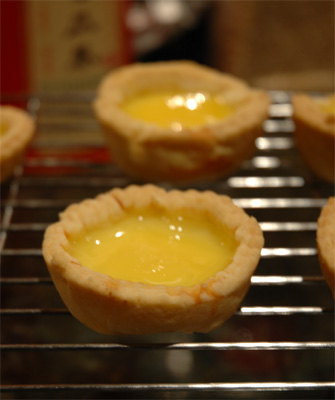
As you can see, they didn’t turn out too bad for a first try, and considering I made them in muffin tins rather than tart tins. However, my first batch was a bit of a miss. I cut the circles too small, and so it couldn’t hold a lot of filling. My mom laughed when she ate one and saw how thin the layer of egg custard was on them! Determined to make a slightly better egg tart, I took the leftover dough from the fridge and made four more slightly bigger ones, using two larger sizes to see which size would be perfect. Ultimately, I think the larger circle makes for a nice size for the tart, since it holds a nice amount of custard. However, it doesn’t fit as nicely into the muffin mold so the crust isn’t completely even, but oh well. You can’t win all the battles.
This is certainly still an ongoing experiment. I’d definitely like to play around with the crust. It turned out really nice and buttery and crisp, but with no sugar added, it was super bland. And I’d like to add one or two more eggs into the custard mixture for a more egg-y flavour. Nonetheless, it was certainly a fun evening making these cute tarts. Definitely less daunting then I thought they would be, especially if you go with the shortcrust.
Wednesday 21 February 2007
Feeling blue
I just realized something: I’m Izzie. For those of you who are devoted fans of the series Grey’s Anatomy, you’ll know what I’m talking about. If I ever experience a bad break-up or something in the future, I’ll probably find myself facing a mountain of cupcakes or something that I had suddenly whipped up without even realizing it.
There’s something therapeutic about baking. Perhaps because it leads you to a predetermined goal: you know that no matter what, there will always be a cake, or muffins, or cookies (whether they were successful or not, mind you!) coming out of that oven. School and the imminent question over my future have been plaguing my mind lately, and needing to occupy my mind on something else for a bit this morning, I decided to relieve some of the stress in the kitchen. Thought it would be ironic to keep my “feeling blue” mood, so I dug around the freezer and found a bag of frozen blueberries. Score! Nothing like waking up to hot muffins straight out of the oven, right?
I used to have a friend who made one of the best blueberry muffins I had ever had. Unfortunately, I was never able to filch the recipe off him…or his mother. However, I have replaced those muffins with another recipe that I have found to be good in its own merits. I’ll be honest, I usually make these only in the summer, when blueberries are actually in season and I can use fresh blueberries rather than frozen ones. However, beggars can’t be choosers, and I HAVE to use my blueberries at some point before I move out in May.
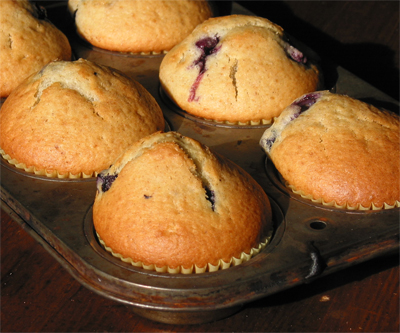
These muffins take no time to put together, and half an hour later, you’ll have hot, yummy smelling muffins greeting you. Only trouble I had was when the fire alarm was set off (that’s what you get when you live with someone who accidentally drops things at the bottom of the oven and doesn’t clean it up!), thus forcing me to stand under the alarm with a tea towel fanning like a madwoman so as not to wake up my dearest Nicole. Brought them to my Italian class, since having food around to tempt me when I’m in one of my moody funks is NOT good. Let’s just say that they went over well, because there’s none left now!
For the recipe, go here.
(N.B. I usually replace the butter with vegetable oil, or a mixture of vegetable oil and applesauce, in order to cut down on the fat a bit. Also, if planning on using frozen blueberries, you might want to consider adding a bit more sugar since frozen blueberries have a tendency to be a bit tarter than fresh ones.)
Monday 19 February 2007
A little change of pace

I hadn't made an "authentic" Chinese fried noodle dish for a while now, so last night I decided that I'd make some Shanghai-Style Fried Noodles for dinner tonight. I still had some raw frozen shrimp in my freezer, and during my daytrip to Winnipeg on Saturday I managed to get some pork tenderloin and Shanghai bok choy... perfect! Being true to my culinary philosophy, I made this without a recipe and relied on my memory on how similar dishes I've had tasted like. So, without further ado, here's my adaptation of one of my favourite noodle dishes (measurements approximate, mind you).
Shanghai-Style Fried Noodles
- 1 ~500g package of Shanghai thick noodles
- Large handful of raw medium-sized shrimp
- 1/5 to 1/4 of a pork tenderloin, shredded
- 2 bunches of Shanghai bok choy*
- 2 cloves of garlic, finely chopped
- ~1 tablespoon cooking oil
- ~1.5 tablespoons oyster sauce
- ~1 tablespoon dark soya sauce
- ~2 teaspoons sesame oil for aroma (optional)
- Salt & pepper to taste
* If Shanghai bok choy is not available, substitute with ~1/4 head of cabbage, shredded.
- Chop the Shanghai bok choy into bite-sized pieces. Separate the thicker, larger stalk pieces from the leaves and the inner, more tender stalks.
- Cook the package of noodles in a pot of boiling water and drain after a few minutes. Cooking instructions normally are on the packaging, please follow accordingly.
- Add the cooking oil to a pre-heated wok (or another pot) over medium-high heat, making sure the entire bottom and a bit of the sides are coated.
- Toss in the garlic, shrimp and pork, stir-fry for about 2 minutes. You may need to add a splash of water to prevent sticking and/or burning.
- Add only the pieces of thicker Shanghai bok choy stalks, toss the ingredients, cover wok and let cook for about 2-3 minutes. If necessary, add another splash of water before covering wok. (If using cabbage, add all the shredded cabbage to the mix, cover and let cook for about 4-5 minutes; skip Step 6 as it does not apply to cabbage.)
- Remove lid and add remaining pieces of bok choy. Toss ingredients, cover wok and let cook for about 2 minutes.
- Remove lid and add the cooked noodles to the wok. After briefly tossing the ingredients, add the sesame oil (if desired) and oyster sauce. Toss again until sesame oil and oyster sauce are evenly mixed.
- Reduce heat to medium and add the dark soya sauce. Toss again until the dark soya sauce coats the mixture evenly. Add salt and/or pepper to taste and serve.
Sunday 18 February 2007
Cleaning out the fridge
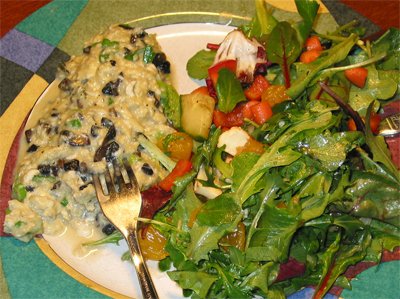
With less than a week before reading week (aka "slack week"), that only means one thing: I need to clear out the fridge by Thursday evening! As a busy university student, I don't always have the time to actually spend hours in the kitchen to fix up dinner (how I wish I did though!). The motto for most school nights is simple, easy, fast, healthy, and delicious.
I tend to always have a little bit of everything leftover. It's as if I get to the "almost end" and then it just sits in the fridge until it goes bad. Upon opening the fridge tonight and taking a peak at my shelf, I naturally found a bit of salad, 5 baby carrots, the butt end of a cucumber, some chopped up red pepper, 3 eggs, 1 portabello mushroom and some green onions. Hating to have anything put to waste, I quickly whipped up a salad dressed with a bit of balsamic vinegar, a dash of olive oil and some mandarin juice to add some sweetness. Whisked 2 eggs with some milk, dried chives and chopped green onions and scrambled them with some sautéed portabello mushrooms, and threw in some shredded cheese right at the end. Lastly, toasted some whole wheat english muffins once, spread them with raspberry jam and topped them with slices of brie and poppped them back in the toaster so that the cheese would melt. Simple. Easy. Delicious! This is one my favourite Sunday brunch meals that I often make for myself at school, but who says you can't have brunch for dinner? And who says you can't eat a good meal without breaking your bank?
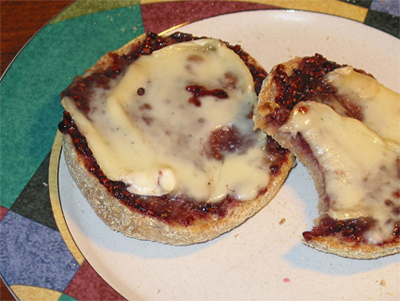
Anyway, on to my promised account of the banana white chocolate muffins. There never seems to be a shortage of bananas in our house. If there aren’t banana sitting in the banana hammock, then there is bound to be bananas sitting in the freezer. Finding myself with the problem of having too many bananas in the freezer, I thought it would be best to use them up. Rather than rely on my tried-and-true banana walnut muffins, or even (possibly) the best banana bread, I thought I would try something new and something a little more special to serve to my friends.
I recently bought a whole bunch of white chocolate, and I had no clue what to do with it. It seems to be a problem of mine; I always buy more than I really need in fear of not buying enough. Thus, white chocolate in one hand, bananas in the other, I made some banana white chocolate muffins.
During my trip to Hong Kong over the Christmas break, I had bought a whole slew of baking stuff, including a couple of cute mini-cake molds. I thought this would be a great time to take them out and break them in. Sprayed them a little with oil so that no sticking would occur (it didn’t…whew!). However, the shape didn’t really show up on the cakes. Next time, I think I’ll just stick to a denser cake recipe (ie: bundt cake) when I use these molds. Regardless, they were still fun, and atleast now I have 8 muffin tops (from the bottom of the mini-cakes) to munch on!
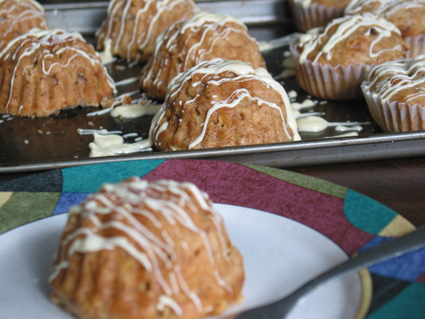
I’m somewhat disappointed with this recipe. I found the taste to be somewhat…odd. There was too much going on with the banana and the white chocolate AND the cinnamon. I’m a classic banana bread lover. I love my banana breads/muffins to have a distinct banana taste to it, with some walnuts thrown in on occasion, and perhaps even some chocolate chips if I’m in desperate need for a sugar high, but the combination of cinnamon and banana just seemed a little odd to my taste buds. Also doesn’t help that I’m not a big fan of white chocolate to begin with. I also threw in some toasted walnuts that I had lying around in the fridge. They’re not bad…I just think this cake is an acquired taste. Regardless of my own opinions, the roomies and my Italian class seemed to enjoy them well enough. I had 8 mini cakes and 16 muffins Saturday evening; they were all gone by last night!
For the recipe, go here.
Biscotti Obsession, Chapter 2
If the culinary world ever held a pageant of some sort for cookies, I know which one I would give my vote for. Ladies and gents, I may have found the sexiest cookie ever. I would like to introduce you to my chocolate espresso biscotti.

As you can well imagine, as with almost every single weekend of mine, it was another bake-fest last night. With an Italian midterm looming over our heads, a couple of us decided to get together for a study group, and that only meant one thing for me: a group of willing guinea pigs at my disposable to try out some of my new experiments in the kitchen!
My obsession with biscotti continued this weekend. I like making biscotti when I bring them to my Italian classmates because: a) it’s in keeping with the Italian frame of mind and b) I can get feedback from my friends who are actually of Italian heritage. With the success of my cranberry and pistachio biscotti last week, I decided to branch out and try something new yet again. As I’ve mentioned before, I had previously attempted making a chocolate biscotti, but I wasn’t quite satisfied with that particular recipe. Inspired by my friend Vincent (who’s hosting the study group), who mentioned something about chocolate biscotti a couple of weeks ago, I thought it was time to have another go at it and try to find a recipe that would finally be a “keeper”.
After some searching, I turned to a recipe at epicurious as the basis of my chocolate biscotti. The original recipe wasn’t very appealing to me to begin with, so it’s funny how I picked this recipe anyway. While I like walnuts, I just didn’t think it would be a great pairing with chocolate; personally, I would substitute hazelnuts or almonds for the walnuts. But nuts aside, I thought that the basic chocolate biscotti would be good for me to play around with.
Thus inspired by Vincent with the idea of a chocolate biscotti and his cappuccino maker, I decided to create my own version of the chocolate espresso biscotti. I threw in 2 tablespoons of finely ground espresso beans (oh Illy, how I love thee!), and replaced the chocolate chips with Poulain’s Noir café, a 64% pure cocoa chocolate bar with coffee in it. The dough did come out dryer than I was used to for a biscotti dough, which did concern me a tad bit, but atleast it meant less of a mess on my hands as I shaped them. The smell of these biscotti while they were baking was absolutely divine, the coffee laced with the chocolate. However, there were two downsides to this recipe: 1) The bottom of my biscotti somehow burned a little after the 1st baking, especially on the ends. I eventually had to scrape off the bottom a bit when I got to the ends because it was just too black, and I wasn’t about to serve burnt biscotti. Still have to figure out why they burned, but I think I have a suspect. 2) These cookies did crumble a bit while cutting, especially when it got to the middle part. I definitely had to be a lot more gentler while cutting these biscotti, but in the end, they still turned out rather nicely with my steady hands and a decent serrated knife.
Nonetheless, all is forgiven (although not totally forgotten) after you’ve tried a bite of these cookies. The cookie is crisp but not to the point where it wants to break your teeth, and it has a very nice, rich chocolatey taste to them. The hint of espresso is absolutely wonderful, and definitely adds a level of depth and complexity to what would otherwise be a very ordinary chocolate biscotti. Mission accomplished! I have finally found a great chocolate biscotti recipe that’s a keeper!
My second batch of biscotti featured cinnamon and hazelnuts, based on a recipe which I found over at Culinary Concoctions by Peabody (lovely blog with even lovelier pictures!). The recipe looked very appealing in itself, since I thought that cinnamon and hazelnut would be such an interesting pairing (and who could resist the seduction of cinnamon?). Add to the fact that the pictures of her biscotti looked beautiful, I decided that I must give these biscotti a try as well.
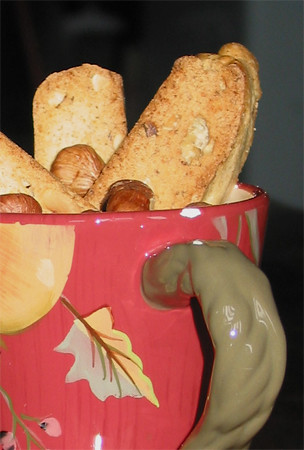
The recipe itself was lovely. The dough was the perfect consistency (not too wet, not too dry), and they cut so beautifully that it almost made me cry. The only change I did make was that I added more cinnamon (1 teaspoon versus the ¼ teaspoon that was recommended) to the batter because I wanted to give the biscotti a more kick. I thought that ¼ tsp would be too little, especially for the amount of flour used, and in my mind.
I was unsure last night whether I liked these biscotti or not. After a night’s rest, however, I have come to the conclusion that these biscotti are lovely. The clincher? Opening the container that I had stored them in last night, I was meant with a sudden whiff of cinnamon. I can only imagine what these little lovely cookies will taste like alongside a cappuccino or a chai latté.
The last thing I made were banana white chocolate muffins, which I will post about tomorrow! A domani!Chocolate Espresso Biscotti
Makes about 30
- 2 cups all-purpose flour
- 1/2 cup unsweetened cocoa powder
- 2 tablespoons finely ground espresso (or 3 tbsp instant espresso
granules)- 1 teaspoon baking soda
- 1 teaspoon salt
- 1/3 cup unsalted butter, softened
- 1 cup granulated sugar
- 2 large eggs
- 3/4 cup semisweet chocolate chips
- Preheat oven to 350°F. and butter and flour a large baking sheet.
- In a bowl whisk together flour, cocoa powder, baking soda, and salt. In another bowl with an electric mixer beat together butter and granulated sugar until light and fluffy. Add eggs and beat until combined well. Stir in flour mixture to form a stiff dough. Stir in walnuts and chocolate chips.
- On prepared baking sheet with floured hands form dough into two slightly flattened logs, each 12 inches long and 2 inches wide, and sprinkle with confectioners' sugar. Bake logs 35 minutes, or until slightly firm to the touch. Cool biscotti on baking sheet 5 minutes. On a cutting board cut biscotti diagonally into 3/4-inch slices. Arrange biscotti, cut sides down, on baking sheet and bake until crisp, about 10 minutes.
Fine Dining at the Forks
It looks like I have the honours of writing up the first restaurant review between the two of us! In any case...
- - -
For the most part, I've had reservations about trying some restaurants in tourist hotspots, as my biggest beef is that a few of these places are essentially culinary tourist traps. Even if the location is memorable, not-so-spectacular food and service can dampen your impression even more than you might first believe. So when I saw Sydney's at the Forks located on the second floor of the Forks Market, tucked amongst the various souvenir and oddity shops, I was at first hesitant to try. However, upon seeing the dinner menu I thought it might have been worth the risk to try this place after all. Apparently I was in for quite a treat.
The first thing you notice about this restaurant is that it shields itself away from the hustle and bustle of the rest of the Forks Market; you can't really hear the hubbub from any of the tables, and only some of the tables (where I was sitting that evening) were along a mixed clear/fogged glass wall with a view of the main floor below. Further enhancing this separation from the rest of the Market is the restaurant's decor. Light-coloured wood panelling mingles with the Market building's original brick walls and pieces of artwork reflecting the international influence of the restaurant's cuisine; a Canada goose sits at a small window, a stylized giraffe stands overlooking the large window overlooking the Forks harbour on the Assiniboine, frozen this time and cleared for hockey and curling rinks, and mini pukel-men face the hidden doors leading to restrooms across the corridor. Topping off the eclectic decor, small 19th-century-style kerosene lamps act as candles on each table.
After making my order from a table d'hote menu that changes monthly (choice of two appetizers, a main course and dessert), I was brought some fresh crusty bread and two types of spread, none of them butter. Though I liked the Mediterranean-flavoured cream cheese with red peppers, I was leaning more to the honey & cumin hummus that was beside it instead. The first item was oxtail broth w/ organic orzo and pearl barley. The broth was reminiscent of consomme, and the thin slices of smoked Angus were very tender, if not posing a mild challenge to put on a spoon. The refreshing taste of the basil pesto helps accentuate the flavour of the broth itself.
Shortly after I was done that came my wild-rice spaetzle. Though I'm not a fan of walnuts, I must admit that its flavour and light crunch melded well with the spaetzle mixed with fresh shiitake mushrooms, while the wine-poached sun-dried blueberries added just a nice hint of sweetness. Interestingly, the chewiness of the spaetzle mixed with the wonderful flavours of the sauce and mushrooms got me thinking for a moment, "This place could've concocted vegetarian shrimp!"
Following a small scoop of peach sherbet to cleanse the palate, my main course of pan-seared salmon arrived, cooked just right so that the fish is still moist. The skin was left uncharred, making it easier to cut through the meat and therefore I would not have bits of salmon scattered all over the plate. It was served on a bed of wild rice with some baby bok choy and a nice mix of caramelized onions, pancetta and pine nuts. Though they all were delicious, I realized that the flavour of the pancetta almost overwhelmed that of the salmon in my mouth a couple of times. The Merlot balsamic reduction was fantastic.
Finally came my creme brulee for dessert. The custard below was smooth and had the right touch of vanilla, while the sugar crust on top was nicely torched. There were no burn specks (something that can easily happen when melting sugar), and the crust was not too much on the caramel side where the sugar would have annoyingly stuck to my teeth for minutes.
No matter what happens in the rest of the Forks Market or how bustling it is out there, Sydney's offers a pleasant, relaxing atmosphere in which one can enjoy some fine food. It's a wonderful surprise in the heart of a highly touristic part of Winnipeg, and it's almost as though this restaurant might seem out of place in the Forks Market. Then again, a lot of the other businesses seem equally out of place as well.
Name: Sydney's at the Forks
Address: 215-1 Forks Market Rd., Winnipeg, MB
Cuisine: International
Price Range: Lunch $28-$38; Dinner $48 & up
Accessible: Yes
Wednesday 14 February 2007
Get Noodled!
I have a confession to make... I have a penchant for noodle dishes. Ever since I was a kid I'd always wanted to scarf down noodles. Perhaps it's because it's a "fun" food to eat, or perhaps it's a craving I somehow picked up. In any case, noodles have been a staple in many cultures around the world, much like bread, potatoes, rice or other starches that can be found today. Although East Asia is arguably a global hub of noodle-dom, other countries and regions have their share in this food realm, and it has also resulted in a large variety of noodles in existence today all over the world in more ways than one.
1. Key Ingredient
What is mixed into the batch can result in completely different textures and tastes. The following are groups of noodles classified by the key ingredient used in the mixture to create them.
A) Wheat Noodles
It can't get any simpler than mixing flour and water at the very least. Wheat-based noodles are easily found worldwide. Most types of pasta for example are made of especially durum wheat. Shanghai-style thick noodles are also wheat-based, as are Japanese udon, yet both types of noodles have completely different textures. Out of Japan also comes soba, a type of thin noodle that is made of buckwheat. I'd have to say that udon noodles are perhaps my favourite right now, but noodles in general have all been in a tight race in my mind for years.
B) Egg Noodles
This type is also found worldwide. In Chinese cuisine however I've tended to notice egg noodles only in southern Chinese (especially Cantonese) cuisine. Italy also has egg noodle pasta, and even southern Germany has its spaetzle. In China there's also a type of noodle that uses only the egg whites; the richer yolk is not added to the mix. Unlike Italian pasta, where rinsing of cooked pasta is considered sacrilegious, the rinsing of most forms of cooked Chinese noodles (especially egg noodles) is actually a must. Fresh Chinese egg noodles (and some forms of wheat noodles) are often covered in a coating of flour (whereas fresh pasta usually isn't). The excess starch therefore has to be rinsed out before the noodles can be ready for use. Cold water is recommended to preserve the firmness of the noodles.
C) Rice Noodles
Rice noodles have originated mainly from the rice-growing regions of East and Southeast Asia. By far the most common forms of rice noodles one can find are flat rice noodles (about half the width of tagliatelle) and rice vermicelli (thicknesses can vary from the equivalent of true vermicelli to spaghetti). Like the other types of noodles noted above found in East and Southeast Asian cuisines, rice noodles are useable in both fried noodle and noodle soup dishes. Although I'm fine with fried rice noodle dishes, I'm personally not so keen with rice noodle soup dishes. I find that the slippery rice noodles somehow make my stomach feel a bit queasy than I've thought they should.
D) Mung Bean Noodles
Mung beans have green shells and yellow kernels and are the seeds of those bean sprouts you see in the supermarket. Yes, noodles can be made from these beans as well. These noodles tend to be as thin as cappelini (angel hair pasta), but unlike pasta, mung bean noodles are chewier. Although they are technically noodles, in Chinese cuisine dishes containing mung bean noodles aren't classified as "noodle dishes", making this type a bit of a culinary oddball. I find they're great mixed in a hot stone pot with either garlic shrimp or satay beef!
E) Konjac Noodles
A special mention must also be made about Japanese konjac (not cognac) noodles. Also known as shirataki noodles, the key ingredient is the konjac (or konnyaku) "yam". The texture is on the chewy side (arguably more so than mung bean noodles), but its low caloric content has some touting it as a health food. Our family was curious enough to try some one night several years ago during a homemade shabu-shabu dinner, and I don't recall us having such dinners without the konnyaku noodles since.
2. Method of Creation
Just as the different ingredient combinations can create different noodles in their own right, how they are created from the dough/mixture itself can also produce different results.
A) Knife Cut
This is the simplest way to make noodles; if you have a knife and a large flat surface in your kitchen, then you can do it. One usually flattens the dough (sometimes one may also gently fold over the dough if it takes up a lot of area) and simply cuts the dough into strips. A good chef can easily cut noodles of even width in quick succession. If you wish to make your own batch of fresh noodles, haven't mastered the art of hand-pulling and don't have your own pasta making machine, this method to amateurs may be crude but is quite effective.
B) Hand Pulled
Also known as lai-mein, creating noodles by the hand-pulling method is by far the most artistic (and IMHO most fun to watch) of all the methods listed here. The idea is that from one piece of dough a noodle maker will stretch it into one large strand, fold it over end-to-end without the two halves sticking to each other, repeat the stretch, fold again, repeat the stretch, and go on so many times until you have a good batch of long thin noodles ready to be cooked and served (just snip the handheld ends and the noodles are primed for a hot water bath). The idea is simple enough, but it's actually more difficult to master than one might think, and the thinner the noodles, the more skillful the noodle-maker is. Hand pulled noodles tend to be slightly chewier than your run-of-the-mill factory made noodles of similar ingredients.
(If you're in the GTA, there's a Chinese fast food stall on the 2nd floor of the Pacific Mall in Markham where someone still openly makes hand pulled noodles. It is definitely worth watching the artistic skill come to life!)
C) Extruded
This is arguably the most popular method in today's world of noodle mass-production, and while legends say Marco Polo brought the idea of noodles from China to Italy, the Italians can lay their claim to fame of creating different shapes of noodles beyond the traditional long strands we so commonly see around the world. How is that possible? Machinery, of course! In this case dough is flattened/compacted and fed through a machine that pushes (or extrudes) the mixture through holes that help create the different shapes from fusilli and wagon wheels to linguine and penne. In order to stock supermarket shelves well today, many other noodles of other culinary cultures are now made using this method.
D) "Fried-to-Go"
Legend has it that a chef in ancient China had just made a batch of noodles when he mistakenly tossed it into a wok full of hot oil, not boiling water. He quickly shuffled the fried noodles into the water, and that was the "accidental" birth of ee-mein or E-fu noodles. You'll see them often packed in "cakes" in Chinese supermarkets, and the noodles feel oily when you remove the packaging as they've already been "pre-fried". However, boil them for a few minutes (they unfortunately have a knack for floating) and they're ready to be used often in either a fried or braised noodle dish.
Many of today's instant noodles you find on your supermarket shelves are still being created using the frying method. The idea behind it is that fresh noodles can't last long unless they're either refrigerated or dried, but dried noodles often take more time to cook. The fried noodles in the instant noodle packages can store far longer than even refrigerated fresh noodles can and only need 3-5 minutes of cooking time (depending on some brands).
My Funny Valentine
Valentine’s Day – a day of love, red roses, and chocolate. Not so much for me, being the single gal that I am. Sadly, I didn’t even have a box of chocolate or ice cream in which to wallow in and contemplate over my nonexistent love life. What’s the next best thing to chocolate and ice cream as therapy? Keeping myself busy in the kitchen, of course!
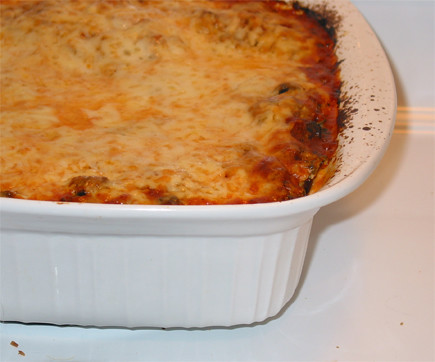
While we may live in the same house, my roommates and I rarely see each other due to our hectic schedules: school, work, extra-curricular and various other events in our lives. Having recently resolved some minor domestic issues that had been building up over the last couple of weeks, I thought it was a perfect time, on Valentine’s Day, to sit down and have a meal together. Dave and Nicole are my family away from home, and what better way to show them my appreciation and love for them than cooking them dinner?
Having a craving for pasta after having endless amounts of salad for lunch and dinner these past few days (mmm…carbs!), it was hard to narrow my choices. Initially, I was just going to be lazy, buy some fresh tortellini from the store and bake them. School was keeping me busy, I had tons of readings to catch up on, and I thought, “Who am I kidding? I don’t have time to make something from scratch!” A few days later, as I was bouncing off ideas with Nicole, she told me she had tons of lasagna noodles sitting on the top shelf of her cupboard. Perfect! The solution to my problem: lasagna.
I had made lasagna only once before, last summer when I had the house all to myself and was having a serious craving for the stuff. I had tried Giada’s recipe, which, while good, wasn’t great, and it was just too much effort to make for something that wasn’t outstanding. Thus, it was back to the drawing boards for me (or more precisely, back to internet searching). This time, I decided to try Martha’s recipe, as a starting point. What I love about this recipe is that it’s simple, it’s easy and you can put everything together in about 15 minutes. The recipe also calls for oven-ready lasagna sheets, something I’ve never used before, but makes the process much easier and faster. Another plus side to using oven-ready lasagna sheets is that you’ll be guaranteed that the pasta won’t be overcooked, and it holds the lasagna together nicely. I was thrilled when I cut the lasagna and served it, and saw that my lasagna slices did not fall apart!
There is something very comforting about food baking in the oven. The smell slowly wafts out and fills the whole house, so that wherever you go, you can smell chocolate, or something sugary, or bananas, butter, bread, or garlic, tomato sauce and cheese. "I love coming home! Every time I walk into the door, it smells like heaven in here," Nicole once said to me. Especially on a cold, winter’s night like tonight, it’s nice to hang out in a warm kitchen, waiting for that lasagna to come out of the oven and catching up with your friends.
All in all, family dinner tonight was a complete success! Both Nicole and Dave thoroughly enjoyed the lasagna, along with garlic bread and Caesar salad. Dave even went for seconds, even though he later confessed to me that he’s actually not a big fan of lasagna. Nothing brings people together like food does!

Dessert was a lazy affair: chocolate cupcakes that I had prepared the night before. I must confess, however, that I cannot take credit for these cupcakes; I made cupcakes from a mix! I know! It’s like some sacrilege or something, but I was just too busy yesterday and feeling really lazy after a long day at school. However, as lazy as I may feel next time around, I will never go back to the cake mix. I had a mini cupcake made from some of the leftover batter last night, and it just tasted so wrong to me! You know you’ve become a food snob when…
Vegetarian LasagnaHappy Valentine’s Day everyone!
adapted from marthastewart.com
Serves 4
- 2 cups whole-milk ricotta cheese
- 1 large egg
- Salt and fresh ground pepper, to taste
- Pinch of fresh ground nutmeg
- 1 package (10 ounces) frozen chopped spinach, thawed and squeezed to remove
excess moisture- About 1 cup mushrooms, chopped
- 2 cloves garlic, minced
- Olive oil
- 3 cups store-bought or homemade tomato sauce
- 1 tsp dried oregano
- Handful fresh basil, chopped
- About 4 ounces no-boil lasagna noodles
- 2 cups fontina cheese, shredded
- Sauté the garlic and mushrooms with a little olive oil in a medium saucepan over medium heat until softened, about 3 to 4 minutes. Add the tomato sauce and the dried oregano; allow for sauce to heat through. Turn off heat and stir in chopped basil. Set aside.
- Preheat oven to 400°F. In a medium bowl, whisk together ricotta cheese, egg, salt, pepper and nutmeg. Add spinach, and stir well to combine.
- Spread a small bit of tomato sauce in the bottom of a 8-by-8-inch baking dish. Arrange a layer of lasagna noodles on top. Spread 1/3 of the ricotta mixture over the noodles, followed by 1/3 of the remaining sauce; sprinkle with 1/3 of the grated cheese. Repeat to make two more layers, ending with cheese.
- Cover with aluminum foil. Bake for 30 minutes. Remove foil; continue baking until top is golden brown, about 15 minutes. Let cool slightly before serving.
(N.B. I used portabello mushrooms in my version, but feel free to use button, cremini or a combination of different mushrooms. I also used a mixture of four cheeses that had been pre-shredded for me, rather than the fontina; mozzarella mixed with some parmesan would also work very nicely! If you find your tomato sauce to be a little on the thick side, add some water, which I did with mine.)
Monday 12 February 2007
Out with the old, In with the new
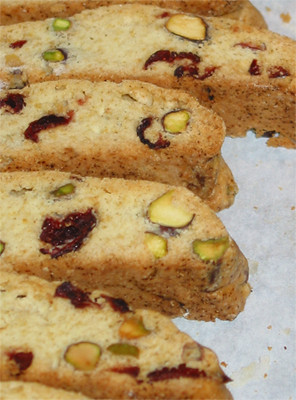
Rewind to three summers ago, when I was a naïve schoolgirl fresh out of high school, with the academic calendar sitting in my lap, pencil in hand, trying for the life of me to pick those first five university courses of my undergraduate career. So many choices, and I’m notorious for not being able to make a choice! However, I ended up taking Beginner’s Italian as one of my electives. Why Italian? I can’t really say, but I knew that with my love for Italian food, Italian films, and thinking that the Italian language is probably one of the most romantic ones out there, I knew I couldn’t go wrong.
Fast forward to present time: I’m now taking Advanced Italian, although to be quite honest, I think my skills in the Italian language is still that of a beginner. My vocabulary is none existent, the grammar rules are getting too complex for my pea of a brain (Hello! There’s a reason why I stopped taking French after 10th grade.), and it seems to be harder for me to get a solid A in each of my assignments and tests. Despite that, Italian remains to be one of my favourite classes, mostly because it’s so small and intimate that you get to know everyone really well, unlike some of my other classes. What’s even better is that our grammar lessons will very often digress into long discussions about Italian culture (including food!), and I often love hearing the stories from my friends who are of Italian heritage.
If there was another heritage I could choose to be, Italian would be it: their food culture is just as rich as China’s own food culture. And what is NOT to love about Italian cuisine (which is my favourite type of food!): fresh pasta in refreshing tomato or rich cream sauces, thin crust pizza, prosciutto, ricotta…need I go on? However, despite the hundreds of Italian dishes that are out there, waiting to be tried, I’d like to introduce to you all to the biscotto.
Biscotto: A long, thin, hard (usually twice-baked) biscuit, typically served with a hot drink, into which it is dipped; plur. biscotti (Oxford English Dictionary). Being the avid baker that I am and having an affinity for sweet things myself, I made my first biscotti four years ago. I always thought that biscotti were complex to make. I mean, they serve it at fancy coffee shops, so of course they must be difficult to make! However, searching through recipes one day for a new cookie recipe, I saw a few recipes for biscotti, and reading over the instructions, I thought to myself, “Hey, I can do this!” It’s pretty much the same concept as making drop cookies, with the exception of dropping them onto a cookie sheet, you shape them into logs, bake them, cut them, and bake them again.
The recipe I chose featured toasted almonds and orange zest, and it was an absolute delight! Everyone who tried them couldn’t get enough of them. I made them as gifts during the holidays and gave them away. People were always badgering me about the recipe. It was pretty much my go-to recipe for biscotti. I have tried several other biscotti recipes in the past: chocolate espresso (while tasty, was much harder to munch on in comparison to my other biscotti), cherry-hazelnut (too hard and somehow I did not like the combination of flavours) and anise (which was too problematic and thus, a failure). While the authentic biscotti typically has a crunchy hard texture to it, perfect for dipping into a hot, frothy cappuccino or a glass of vin santo, I like mine to not break my teeth if I just eat them by themselves. But my go-to biscotti were just perfect: they held their shape beautifully, but when you bit them, they didn’t break your teeth!
However, after four years of making and serving my oh-so-trusted biscotti, I decided a few days ago that I’ve had enough. It was time to find a new biscotti recipe to add to my repertoire, one that was a definite keeper and that would bring more variety to my cookie platter in the future. I searched high and low for days, doing a thorough research of MANY different biscotti recipes before I narrowed it down to one that seemed plausible and tempting: Cranberry Pistachio Biscotti. I never really was a big fan of cranberries. I never really liked that slightly bitter aftertaste you’d always get in your mouth after eating them (or after drinking cranberry juice, which I also dislike). However, my recent rediscovery of my love for pistachios made me ignore the fact that I’d be forced to use cranberries. I headed over to Bulk Barn, bought a bag of pistachios and dried cranberries (along with a lot of other baking crap that I can never seem to NOT buy) and hunkered down Saturday evening to bake some biscotti.
Boy, am I glad I got fed up of baking my old biscotti recipe, because I think I found a new favourite. Not only were these absolutely delicious, but they also had a lovely texture (not too hard yet not too crumbly either) and they look absolutely GORGEOUS! I almost felt tempted to lug out our mini Christmas tree (uh…more like Christmas bush) from the storage room and celebrate Christmas all over again. The sprinkling of the green pistachios and the red cranberries throughout the cookie made the biscotti look super attractive and super sexy. Who would have thought that just a mere cookie could add so much colour into our drab grey student apartment? I also dipped one side of them in some melted Belgium white chocolate, and then drizzled some melted Belgium milk chocolate on top, making them look every prettier and more special.
Tested them out on some willing guinea pigs tonight and they loved it, so this recipe will definitely be added to my cookie repertoire!
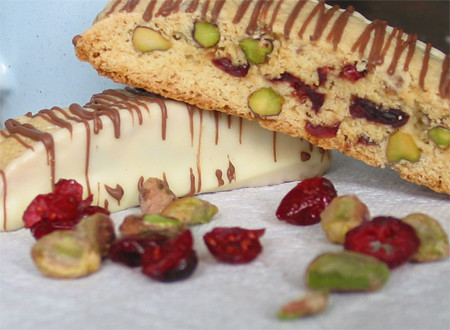
Interesting side note for those of you who don’t know already: biscotti means “twice-baked” in Italian, and while we North Americans tend to consider biscotti as that delightful Italian cookie that’s thin and long, and lovely when dipped in an espresso or cappuccino, biscotti refers to cookies in the generic sense in Italy. So if you find yourself in Italy and desiring a biscotti, ask for a cantucci.Cranberry Pistachio Biscotti
adapted from the original recipe found here
Makes about 2 to 3 dozen (depending on how big you cut them)
- 1/4 cup light olive oil
- 3/4 cup white sugar
- 2 teaspoons vanilla extract
- 1 teaspoon almond extract
- 2 eggs
- 1 3/4 cups all-purpose flour
- 1/4 teaspoon salt
- 1 teaspoon baking powder
- 1/2 to 2/3 cup dried cranberries
- 1/2 to 2/3 cup pistachio nuts (preferably raw, unsalted; if using salted, you should omit the salt!)
Preheat the oven to 300 degrees F (150 degrees C).
In a large bowl, mix together oil and sugar until well blended. Mix in the vanilla and almond extracts, then beat in the eggs. Combine flour, salt, and baking powder; gradually stir into egg mixture. Mix in cranberries and nuts by hand.
Divide dough in half. Form two logs (12x2 inches) on a cookie sheet that has been lined with parchment paper. Dough may be sticky; wet hands with cool water to handle dough more easily.
Bake for 35 minutes in the preheated oven, or until logs are light brown. Remove from oven, and set aside to cool for 10 minutes. Reduce oven heat to 275 degrees F (135 degrees C).Cut logs on diagonal into 3/4 inch thick slices. Lay on sides on
parchment covered cookie sheet. Bake approximately 8 to 10 minutes, or until dry; cool.(N.B. I didn't reduce the oven heat for the second bake, but it all depends on your oven. If your oven runs hot, then you might want to consider reducing the heat. And it always helps to keep an eye on your biscotti during the second baking.)
Sunday 11 February 2007
Cooking without a recipe?
It's definitely possible, and it's actually not as difficult (or intimidating as it sounds). Although I was able to cook some basic dishes without recipes, I was greatly inspired to expand my ad lib horizons by Canadian chef Michael Smith, especially by his latest show Chef at Home. Granted, there are still some things that are better done with a recipe on hand, but I usually feel more liberated when I can cook some nice dishes without having to fumble with a cookbook in the middle of a cooking process. For one thing, sometimes I just don't have the time. Finding a recipe takes time to research and assess, and then I'd have to interrupt myself constantly to review the recipe as I make the dish in question. Also, unless it's for a special occasion I'm not going to stock up on some of the ingredients that may be called for by some recipes, be it due to lack of storage space or the freshness factor. Cooking ad lib gives me the freedom of flexibility and creativity... and I can better guarantee that the dishes I make are ones that I will enjoy eating!
Some good tricks to cooking ad lib are to trust your instincts (and experiences) and to be creative.
1. Instincts & Experiences
You can hone your cooking instincts not only through practice by cooking again and again, but also by trying different foods and dishes made by others, remembering what did or did not jive with your taste buds. Get to know your ingredients; keep in mind how their flavours would affect the dishes you create when you add them to the mix. Also, you know what combination of flavours you like, cook your dishes to reflect your personal tastes. Remember, eating is supposed to be enjoyable, not a chore.
Observing how others cook and experimenting with your cooking methods can also help. For example, until recently I've had trouble stir-frying raw broccoli pieces evenly. I remember seeing some cooking shows where vegetables were steamed to cook without losing their crunchiness or nutritional value, so I solved my own little problem by pre-steaming my broccoli pieces before mixing it up in my final stir-fry dishes. Find ways that can help you cook better, and once you find a method that's most comfortable with you, go for it. If it didn't work for you, remember why and keep looking for a better alternative.
2. Creativity
Although repetition allows you to hone your cooking instincts, things can start to feel bland when you continue making the usual same-old, same-old. Using your accumulated experiences and your instincts, go nuts with experimenting different mixes of ingredients to create variations of tried-and-true dishes or even to create new dishes of your own. The choice is yours as to how far you wish to go down the creativity spectrum, from incremental all the way to wholesale. Even the simplest changes can be enough to fool your taste buds into a different taste experience.
Also, changes are sometimes necessary due to the ingredients that you have (or don't have); it's been defined by Iron Chef as "situation substitution". In those cases, your instincts and experiences will be very helpful to you. For example, I remembered a Chinese dish of braised nappa cabbage in a thick sauce with shredded shiitake mushrooms and Chinese ham and thought of trying to make that for the first time recently. I already had the mushrooms and cabbage, but I couldn't get the Chinese ham. However, I had some Chinese sausage, and in the end it actually was a decent substitute for the Chinese ham in this dish.
Don't be afraid to cook without a recipe. In the long run you can only become a better cook, and the possibilities are quite endless for you out there.
Saturday 10 February 2007
A further introduction...
It looks like my sister has "cooked the pasta al dente"! OK, so it's a corny variation to "hitting the nail on the head", but with the subject matter this blog covers I couldn't help it. However, I would like to take the opportunity to put in my perspective into this joint enterprise.
Who am I? I'm Andrew, a 24-year-old small-city planner in Manitoba. I've always had in interest in exploring, and that includes actual travel, and culinary exploration. Be it through eating out or cooking up a storm at home, I love to indulge my palate whenever I can. The way I see it, food will always be about you one way or another, and we also always need to eat, so why not appreciate it to its fullest?
Until I moved out of my parents' home during my university years I never really had a knack for cooking, though I did already enjoy savouring foods from many parts of the world. By the end of my frosh year, the 9-10 months of caf food and the realization that I'll have to cook my own food beginning the following year snapped me back to reality, and like my sister, I too have my mother to thank. She can cook very well, and she doesn't hesitate to try cooking new things, be it her home turf of Chinese cuisine or something more foreign or exotic. I in turn have been inspired to try widening my cooking horizons (when time permits... my studies, and now my work schedule, can get in the way once in a while) and also to try different foods and cuisines.
With my sister's and my love for food in general, it seemed natural for us to get together (far apart as we may physically be) and start up this blog. Food should be enjoyed by all whenever possible, so why keep this subject secret or silent? I also hope that I can help open the eyes of some of you out there to some of the good and/or unique foods that may be out there waiting for you to try. Though I'll admit I'm perhaps a bit more partial to the "fine dining" side of things (my love for such food shows as the original Iron Chef and my occasional craving for things like foie gras or abalone is proof of that!), good food does come from many places, and I'm certainly open to try some where they can be found, be it "fine dining", "home cooking", or any other way you can label it.
One more thing... Bonita summed it up nicely about "Forks & Chopsticks", but I think I can throw another angle to it. She and I are undeniably of Chinese origin, but we were born and raised in a Western country with a predominantly Canadian/North American culture, and I think it's safe to say that our philosophy on food is partly molded by our family, but also partly molded by the society to which we've been exposed. Let's face it, Canada has a good mix of cultures from around the world, and it has its own distinct history and culture, so exposure to other foods is practically unavoidable. At the same time, we like to reach back to our cultural roots, which is why we still haven't abandoned Chinese cuisine.
"Forks & Chopsticks", ladies and gentlemen... bon apetit!
A little introduction...
“Tell me what you eat, and I will tell you what you are.” – Anthelme Brillat-Savarin
For years, I’ve seen the above quotation at the beginning of Iron Chef (the original Iron Chef that is!). There is also that cunning saying, “You are what you eat.” Food has always been a huge part of my life. Who am I kidding? Food IS my life. And what better way to indulge in food than by sharing it with others?
But first, a little about myself for those of you who don’t already know me! I’m 20, and I’m currently an university student studying English Literature in good old Southwestern Ontario. While I do harbour a love for literature, I also have a deep passion for food. Sometimes I can’t seem to get my mind off it: I can’t stop at a bookstore without browsing through the cooking section, I’m constantly on the web surfing for new recipes and I’ve caught myself on several occasions drifting off during lectures as I planned my weekly dinner menu.
Don’t get me wrong…I have indulged once or twice in the ever-so-popular college dish of KD (with hot dogs!), and sometimes find myself packing a peanut butter and honey sandwich (I can’t stand PB&J!) to school. However, being a student who really doesn’t have a huge budget to work nor a lot of time has never stopped me from my culinary adventures in the kitchen. Cooking and baking is not only a way of life for me, it’s an escape from my real life. For that one hour or so where I’m in the kitchen, I can forget about books, readings, papers, marks, the stress of school, and just focus all my energy on producing a delicious dish. People have often asked me why I love baking and cooking so much, and I tell them it’s a form of therapy for me. Some people pay $200/hour to have a certified doctor listen to the drama of their lives; I bake. What makes cooking/baking so therapeutic for me is that you always have an acknowledged target in the end. I know that at the end of it all, after all the hard work and effort I put into it, I’ll have something delicious waiting for me; I could spend weeks on a paper, have it all printed it and ready to hand in, and still have it be a piece of crap, never quite satisfying my need for perfection.
I believe I have my mother to thank for all this. My mother, like most mothers, is an AMAZING cook, and thus it is no surprise that I grew up in an environment where food was appreciated. My parents always encouraged my brother and I to try new foods at least once, and I thank them for that. Sure, as kids, we may have found some of the foods that we did try “weird” (and I always make the claim nowadays that I’m pretty much used to “weird” food because of my Chinese heritage). But trying all different kinds of foods also allowed us to broaden our palette and to be introduced to new and different things. It also allowed us to not be afraid of food and thus, be adventurous, daring and experimental as we grew older.
I think my love for food has strong connections to my Chinese heritage as well. Like many cultures around the world, food also plays a dominant role in Chinese culture. Food is seen as a way of harmonizing and bringing together a household and a family, and China’s own culinary history is extremely rich and complex. To grow up in such a culture certainly helps fuel one’s love and appreciation for food, especially in a food culture that features hundreds of different dishes and dozens of different regional cuisines.
Thus my reason for starting up this food blog with my brother, Andrew. It’s a chance for us to share our own love and appreciation of food with others, whether it’s inside the kitchen or not. We are both lucky to have been nurtured by parents who love and enjoy food, and a mother who loves to cook. Cooking for me is not only a way to experiment with new recipes and to treat myself to something delicious to eat; it’s a form of expression for me as well. While I enjoy tasting my own creations, nothing leaves me more satisfied than cooking for others. This blog will also allow me to be closer with my brother, who’s now a working man in the middle of nowhere. I don’t get to see him very often nowadays, nor talk to him as much, but it hasn’t diminished our mutual love for food. I always find that when we do talk to each other, we’re sharing our cooking experiments, recipes, cool finds from the market/grocery store and new restaurants we’ve tried/dying to try.
As for the title “Forks & Chopsticks”, it refers to a couple of things that are personal to us. The “Chopsticks” element refers to our Chinese heritage; we grew up using chopsticks, and no matter what, it will always be synonymous to food for us. Secondly, the element of forks and chopsticks represents two vastly different eating utensils: the fork is a Western invention, while the chopstick is an Eastern one. This dichotomy represents our own philosophy when it comes to food. We both enjoy Western cuisine and Eastern cuisine; what’s even great is when we get experimental and try Fusion cuisine. And that, my friends, is the story behind “Forks & Chopsticks”…

